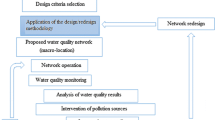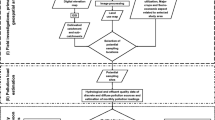Abstract
The number of water quality monitoring stations in the USA has decreased over the past few decades. Scarcity of observations can easily produce prediction uncertainty due to unreliable model calibration. An effective water quality monitoring network is important not only for model calibration and water quality prediction but also for resources management. Redundant or improperly located monitoring stations may cause increased monitoring costs without improvement to the understanding of water quality in watersheds. In this work, a decision-making methodology is proposed to design a water quality monitoring network by providing an adequate number of monitoring stations and their approximate locations at the eight-digit hydrologic unit codes (HUC8) scale. The proposed methodology is demonstrated for an example at the Upper Colorado River Basin (UCRB), where salinity is a serious concern. The level of monitoring redundancy or scarcity is defined by an index, station ratio (SR), which represents a monitoring density based on water quality load originated within a subbasin. By comparing the number of stations from a selected target SR with the available number of stations including the actual and the potential stations, the suggested number of stations in each subbasin was decided. If monitoring stations are primarily located in the low salinity loading subbasins, the average actual SR tends to increase, and vice versa. Results indicate that the spatial distribution of monitoring locations in 2011 is concentrated on low salinity loading subbasins, and therefore, additional monitoring is required for the high salinity loading subbasins. The proposed methodology shows that the SR is a simple and a practical indicator for monitoring density.






Similar content being viewed by others

References
Ammar, K., Khalil, A., McKee, M., & Kaluarachchi, J. (2008). Bayesian deduction for redundancy detection in groundwater quality monitoring networks. Water Resources Research, 44(8), W08412. doi:10.1029/2006WR005616.
Ammar, K., McKee, M., & Kaluarachchi, J. (2011). Bayesian method for groundwater quality monitoring network analysis. Journal of Water Resources Planning and Management, 137(1), 51–61. doi:10.1061/(ASCE)WR.1943-5452.0000043.
Anning, D. W., Bauch, N. J., Gerner, S. J., Flynn, M. E., Hamlin, S. N., Moore, S. J., et al. (2007). Dissolved Solids in Basin-Fill Aquifers and Streams in the Southwestern United States: U.S. Geological Survey, Scientific Investigations Report 2006–5315. Reston, Virginia.
Boiten, W. (2000). Hydrometry. Rotterdam: Balkema.
Davis, D. R., Duckstein, L., & Krzysztofowicz, R. (1979). The worth of hydrologic data for nonoptimal decision making. Water Resources Research, 15(6), 1733–1742. doi:10.1029/WR015i006p01733.
Dymond, J. (1982). Raingauge network reduction. Journal of Hydrology, 57(1–2), 81–91. doi:10.1016/0022-1694(82)90104-4.
Gilroy, E. J., & Moss, M. E. (1983). Cost-effective streamgaging strategies for the Lower Colorado River basin, U.S. Geological Survey, Open-File Report 81–1019. Open-File Report. Reston, Virginia.
Harmancioglu, N. B., & Alpaslan, N. (1992). Water quality monitoring network design: a problem of multi-objective decision making. Journal of the American Water Resources Association, 28(1), 179–192. doi:10.1111/j.1752-1688.1992.tb03163.x.
Herschy, R. W. (1999). Hydrometry: principles and practice (second edition). West Sussex: Wiley.
Husain, T. (1989). Hydrologic uncertainty measure and network design. Journal of the American Water Resources Association, 25(3), 527–534. doi:10.1111/j.1752-1688.1989.tb03088.x.
Kenney, T. A., & Buto, S. G. (2012). Evaluation of the temporal transferability of a model describing dissolved solids in streams of the Upper Colorado River Basin. Journal of the American Water Resources Association, 48(5), 1041–1053. doi:10.1111/j.1752-1688.2012.00667.x.
Kenney, T. A., Gerner, S. J., Buto, S. G., & Spangler, L. E. (2009). Spatially Referenced Statistical Assessment of Dissolved-Solids Load Sources and Transport in Streams of the Upper Colorado River Basin: U.S. Geological Survey, Scientific Investigations Report 2009–5007. Reston, Virginia.
Kenney, T. A., Gerner, S. J., & Buto, S. G. (2012). Analysis of annual dissolved-solids loading from selected natural and irrigated catchments in the Upper Colorado River Basin, 1974–2003. U.S. Geological Survey, Scientific Investigations Report 2012–5090. Reston, Virginia.
Keum, J., & Kaluarachchi, J. J. (2015). Calibration and Uncertainty Analysis Using the Sparrow Model for Dissolved-Solids Transport in the Upper Colorado River Basin. Journal of the American Water Resources Association. doi:10.1111/1752-1688.12302
Langbein, W. B. (1979). Overview of conference on hydrologic data networks. Water Resources Research, 15(6), 1867–1871. doi:10.1029/WR015i006p01867.
Mishra, A. K., & Coulibaly, P. (2009). Developments in hydrometric network design: a review. Reviews of Geophysics, 47(2), RG2001. doi:10.1029/2007RG000243.
Mooley, D. A., & Mohamed Ismail, P. M. (1981). Network density for the estimation of areal rainfall. Hydrological Sciences Bulletin, 26(4), 369–378. doi:10.1080/02626668109490901.
Moss, M. E. (1979). Some basic considerations in the design of hydrologic data networks. Water Resources Research, 15(6), 1673–1676. doi:10.1029/WR015i006p01673.
Moss, M. E., & Gilroy, E. J. (1980). Cost effective stream-gaging strategies for the Lower Colorado River basin; the Blythe field office operations. U.S. Geological Survey, Open-File Report 80–1048. Reston, Virginia.
Nolan, J. V., Brakebill, J. W., Alexander, R. B., & Schwarz, G. E. (2003). Enhanced River Reach File 2.0. U.S. Geological Survey, Open-File Report 02–40. Reston, Virginia.
Schwarz, G. E., Hoos, A. B., Alexander, R. B., & Smith, R. A. (2006). The SPARROW Surface Water-Quality Model: Theory, Application and User Documentation: U.S. Geological Survey Techniques and Methods Book 6, Section B, Chapter 3. Reston, Virginia.
Seaber, P. R., Kapinos, F. P., & Knapp, G. L. (1987). Hydrologic Unit Maps, U.S. Geological Survey, Water-Supply Paper 2294. Denver, Colorado.
Spence, C., Saso, P., & Rausch, J. (2007). Quantifying the impact of hydrometric network reductions on regional streamflow prediction in Northern Canada. Canadian Water Resources Journal, 32(1), 1–20. doi:10.4296/cwrj3201001.
Strobl, R. O., & Robillard, P. D. (2008). Network design for water quality monitoring of surface freshwaters: a review. Journal of Environmental Management, 87(4), 639–648. doi:10.1016/j.jenvman.2007.03.001.
Strobl, R. O., Robillard, P. D., Day, R. L., Shannon, R. D., & McDonnell, A. J. (2006). A water quality monitoring network design methodology for the selection of critical sampling points: part II. Environmental Monitoring and Assessment, 122(1–3), 319–334. doi:10.1007/s10661-006-0358-4.
U.S. Geological Survey. (1999). Streamflow Information for the Next Century, A Plan for the National Streamflow Information Program of the U.S. Geological Survey: U.S. Geological Survey, Open-File Report 99–456. Denver, Colorado.
U.S. Geological Survey. (2013). National Water Information System: Web Interface. http://waterdata.usgs.gov/nwis. Accessed 10 September 2013.
World Meteorological Organization. (2008). Guide to Hydrological Practices, Volume I Hydrology – From Measurement to Hydrological Information, WMO-No. 168 (Sixth.).
Author information
Authors and Affiliations
Corresponding author
Rights and permissions
About this article
Cite this article
Keum, J., Kaluarachchi, J.J. Development of a decision-making methodology to design a water quality monitoring network. Environ Monit Assess 187, 466 (2015). https://doi.org/10.1007/s10661-015-4687-z
Received:
Accepted:
Published:
DOI: https://doi.org/10.1007/s10661-015-4687-z



